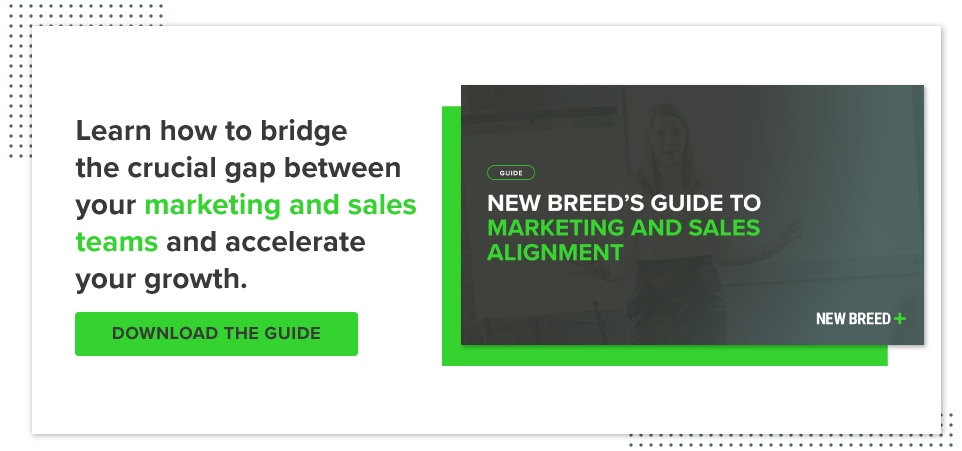5 Properties You Must Use for Marketing and Sales Alignment

It has never been more important for marketing and sales teams to be aligned, but making this alignment a reality among people, processes and platforms is not easy. However, with increasingly sophisticated marketing-automation platforms and CRMs that break down the information silos of these two departments, it is entirely possible. They enable not only alignment, but also closed-loop analytics, transparency into service-level agreements, goal tracking and marketing contribution to pipeline. The question then becomes, what information do I need to pass between my CRM and marketing-automation platform? Well, here are five key contact properties (with examples) that are crucial to aligning these two departments.
Get marketing + sales on the same page with these five contact properties.
1. Lifecycle stage
Lifecycle stages allow you to group and segment contacts based on where they are in the sales cycle, thus letting teams define clear ownership of a contact. For example, leads who are not yet marketing qualified are owned by marketing, sales qualified leads and opportunities are owned by sales, and customers are owned by the customer success team.
These stages can be customized for any organization, but we've found great success using the lifecycle stages defined by HubSpot and summarized below:
|
Subscribers |
Subscribed to blog or periodic emails. Only their email address is known and they have not engaged with other premium/gated content. |
|
Leads |
Have engaged with premium content but has not raised a hand to request an assessment of any kind and is still at the top or middle of the funnel. |
|
Marketing Qualified Leads (MQL) |
MQLs for short, have reached the bottom of the funnel having met the agreed-upon criteria with the sales team to be deemed ready for handoff, having shown enough interest and being a good potential fit for your company. |
|
Sales Qualified Leads (SQL) |
Have been accepted by the sales team for direct follow up. |
|
Opportunities |
Have an opportunity associated with them in your CRM. |
|
Customers |
Are or have ever been a customer of your company. |
|
Evangelists |
Contacts that may never be customers but are advocates of your brand and may refer potential customers to you. |
|
Other |
This can be used for a few different purposes depending on the needs of your team, whether they be closed-lost opportunities, key accounts, poor fit contacts or dead leads. |
2. Lead score
Lead score is a numeric system put in place between marketing and sales teams that enables a ranking of leads based on agreed-upon criteria to determine sales readiness. These factors are generally made of both implicit information collected through analytics (number of website visits, number of form submissions, etc.) and explicit data points collected on a form (title, role, industry, phone number, etc.) that determine when a lead will be deemed ready to pass on to sales and when further nurturing by the marketing team is needed.
Lead scoring is important for two main reasons:
- Holds marketing accountable to deliver leads that meet this agreed-upon criteria encouraging alignment, while simplifying the lead handoff and follow-up process.
- Increased sales productivity. According to Marketo, a 10 percent increase in lead quality can translate into a 40 percent increase in sales productivity.
A 10% increase in lead quality can translate into a 40 percent increase in sales productivity.
3. Lead status
If you follow up with Web leads within four minutes, you're nine times more likely to convert them. With this in mind, make sure that you're correctly tracking what stage of the follow-up process a lead is in once it has been passed off to sales. Generally, a lead will be tagged as "new" once it is passed to sales and sales updates the status to reflect that it is attempting to contact the lead. The goal of the lead status should be to have the lead either end up being marked as "unqualified" or "qualified." If you use Salesforce, this is when a lead would be moved from the lead to contact object.
|
Lifecycle |
Status |
Definition |
Notes |
|
MQL |
New |
New to the database, no activity has been logged. |
First attempt to contact should happen within 24 hours of MQL notification being sent. |
|
SQL |
Attempting to Contact (In Progress) |
Activities are being logged (emails sent, voice mails being left), but they have not reached the contact. |
At least 5 contact attempts should be made |
|
SQL |
Contacted (Open) |
Conversation has occurred or the target person has been engaged, but still trying to determine "fit" to know if they are qualified. Activities logged. |
|
|
Opportunity |
Qualified |
The person is either interested in getting pricing or a proposal, budget, timeline, pain, industry determined. They have a need in the near future (30-60 days) and you want to start tracking this on your sales pipeline. |
|
|
Other |
Unqualified |
Not a fit. Not in the target demographic, or they don't buy or use your product/service. No further activities should be logged. |
Reason for disqualification property must then be defined. |
|
Lead |
Long term follow-up (Speed 2) |
Contacts that are the right target audience or demographic, but there is no immediate opportunity to pursue today. Create an activity for future follow-up. |
This group should be participants in any long-term drip marketing or nurturing campaigns. |
|
Lead |
Dead or No Response |
The contact went radio silent on you. |
Set internal guidelines on how many contact attempts should be logged before using this status. |
4. Reason for disqualification
If the lead was not qualified, it's best to close the loop and provide feedback to the marketing team on why the leads it's passing off are not qualified. This way, the marketing team can make the necessary changes to improve. This can be structured differently based on the type of business, but the classic BANT framework is a good starting point:
- Budget
- Authority
- Need
- Timeline
5. Opportunity Stage
Finally—if a lead has been qualified and was converted to a contact with an associated opportunity—it is important to have clearly defined opportunity stages tracking the percent-to-close win rates of that opportunity. This allows for accurate sales forecasting.
With the HubSpot and Salesforce integration, opportunity stages also help define the lifecycle stage of a contact. For example, if an opportunity record associated with a contact is marked as "closed won" in Salesforce, then the contact's lifecycle stage in HubSpot will automatically be updated to Customer.
|
Stage |
Probability (%) |
|
Needs Analysis |
20 |
|
Value Proposition |
50 |
|
ld. Decision Makers |
60 |
|
Perception Analysis |
70 |
|
Proposal/Price Quote |
75 |
|
Negotiation/Review |
90 |
|
Closed Won |
100 |
|
Closed Lost |
0 |
There are, of course, other important properties that we haven't covered in today's post that help further track and forecast sales and marketing's contribution to the pipeline. However, these are five core properties that we've found are a crucial starting point to clearly define lead ownership and expectations between marketing and sales departments.
What other ways do you align your marketing and sales teams? Where is there a breakdown in alignment? We'd love to hear.







